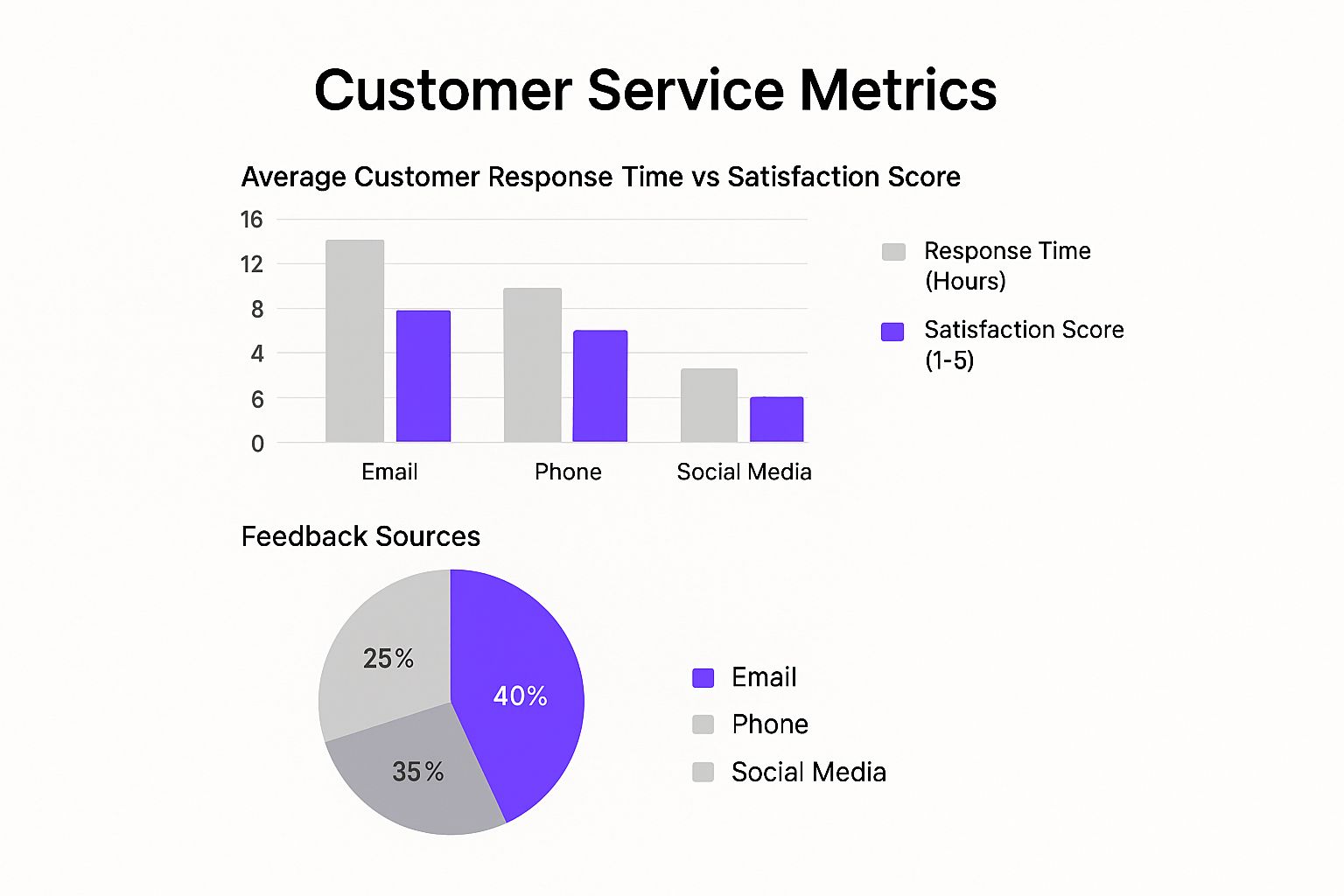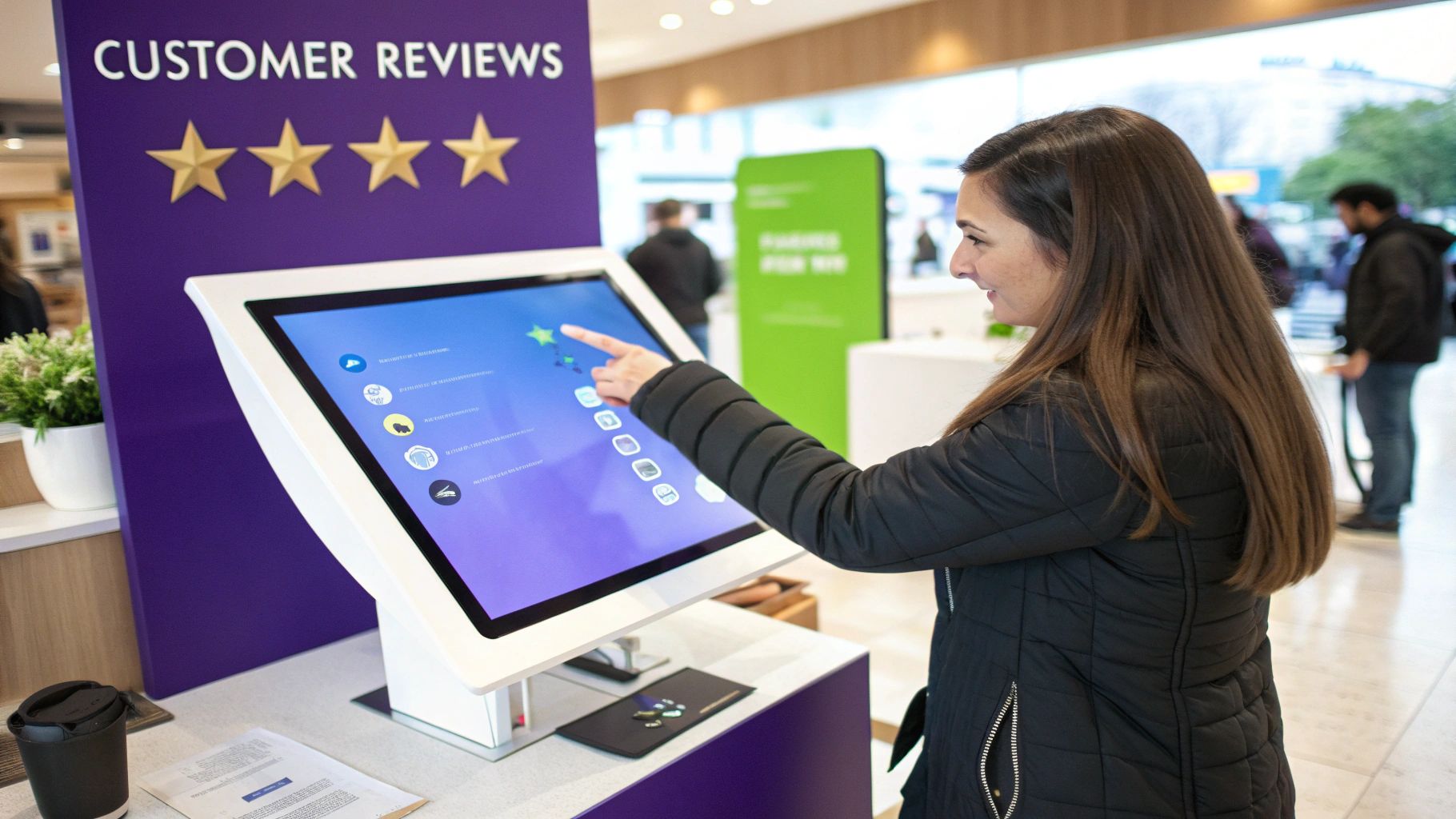How to Build Customer Trust: Proven Strategies for Success
Learn how to build customer trust with proven strategies. Discover actionable tips to strengthen relationships and boost loyalty today.
Posted by
Why Trust Became Your Business Superpower
Let's be honest: trust isn't just some feel-good factor anymore. It's the foundation upon which modern businesses either thrive or crumble. Think about it – today's consumers face a constant barrage of options. They're also savvy to misleading marketing, data breaches, and shady business practices. This makes trust the ultimate competitive edge. It's the make-or-break factor that determines whether a customer chooses you or your competitor. Would you hand over your credit card to a company you didn't trust? Doubtful.
This increased consumer awareness translates directly into buying behavior. Building trust is no longer optional—it's essential for success. Brand trust heavily influences customer loyalty and purchasing decisions. Edelman research shows that almost 70% of consumers need to trust a company before buying from them or continuing to do so. That's a huge number. This highlights just how vital it is for businesses to prioritize strategies that build trust. For example, responsible handling of customer data is now a cornerstone of trust. One global survey found that 83% of people believe data protection is fundamental for building trust. For a deeper dive into the stats around brand trust, check out this resource: How Important is Brand Trust - Key Statistics & Data.
Beyond customer loyalty, trust directly impacts your bottom line. Businesses that enjoy high levels of customer trust typically see higher customer lifetime value, reduced acquisition costs, and more predictable revenue. Why? Because loyal customers—the kind born from genuine trust—are more likely to buy from you repeatedly and recommend you to their network. This kind of organic growth through word-of-mouth is pure gold, especially as traditional advertising continues to lose its effectiveness.
Finally, let's talk long-term impact. Trust acts as a safety net during tough times. When things go wrong (and they inevitably will), having a reservoir of trust gives your company the benefit of the doubt. This resilience is priceless for safeguarding your brand's reputation and keeping customers even when you stumble. So, trust isn't just about good customer service; it's about building a sustainable business that can weather any storm and flourish in a competitive market.
Making Digital Interactions Feel Genuinely Human
Your website isn't just a collection of pages; it's your digital handshake. It's where you make that crucial first impression, and believe me, that impression can solidify or shatter customer trust before you even realize someone's checking you out. Too many businesses treat their online presence like a cold, impersonal transaction, forgetting the essential human element of trust-building.
This rings especially true with younger audiences. Gen Z and Millennials are incredibly perceptive when it comes to authenticity. They can spot a fake a mile off. If your website feels robotic or impersonal, they'll judge your entire business based on that single interaction. Think about your own online experiences. Where do you feel more comfortable spending your money – a website that feels warm and welcoming, or one that feels like it was built by robots?
So, how do you create digital experiences that feel genuinely human? One powerful way is by injecting some real personality into your online interactions. Ditch the stiff, corporate jargon and embrace a conversational tone. Share your company's story, your values, and even some of the bumps in the road you've encountered. This vulnerability creates a connection and shows the real people behind the brand.
For example, instead of a generic "About Us" page that reads like a corporate brochure, share some real stories about your company's journey. What sparked the idea for your business? What obstacles did you overcome? This creates a sense of shared experience with your audience.
Also, use real photos and videos of your team. Let your customers see the faces behind the brand. This simple act can have a surprisingly big impact on how people perceive your business. It’s about building genuine connections, not just transactions.

In today's world, both in-person and digital customer experiences are equally vital for building trust. Adobe's 2022 Trust Report found that digital experiences are now just as crucial as in-person interactions, especially for younger consumers. This is reflected in the projected growth of the customer experience management market, expected to expand at a CAGR of 15.8% from 2024 to 2030, from its $12.04 billion value in 2023. This underscores the importance of making your digital interactions a key part of your trust-building strategy. Remember, building customer trust is a holistic effort. Every touchpoint matters, and your digital presence is no exception.
Transforming Support Interactions Into Trust Goldmines
Your customer service team isn't just there to put out fires. It's a goldmine for building incredible customer loyalty. Smart businesses get this. They're turning everyday support calls into opportunities that actually boost trust. It’s not just about fixing the issue; it’s about showing you truly care and building a stronger connection. Think about a time a company went the extra mile for you. You probably stuck with them, right?
That's the power of great customer service.
Every interaction, from live chats to social media replies, is a chance to build trust. Training your team to spot and use these “trust moments” is key. For example, giving your support team the power to offer personalized solutions, even something small like a discount on a future purchase, can turn a frustrated customer into a loyal fan.
And let's not forget about exceptional service recovery. This is where you don’t just fix the problem, you go above and beyond. This can turn even your angriest customers into your biggest advocates. You might even want to check out how to write a testimonial from these happy customers after their positive support experience.

Enhancing Digital Interactions
To smooth out certain support processes, you could consider how to add chatbot to website. But remember, keeping that human touch is crucial to your overall strategy. This is where investing in great customer service really pays off. It creates this amazing ripple effect. Happy customers become repeat customers, and then they start telling their friends. It’s a win-win that fuels both customer retention and organic growth.
This focus on customer service isn't just a fad, it's a movement. The global customer service software market is currently worth about $14.9 billion and is expected to hit $68.19 billion by 2031. That’s a CAGR of 20.94% between 2024 and 2031. This shows just how important customer service is for building and keeping customer trust. Over 50% of businesses outsource customer service – everything from live chat and phone support to social media management – to improve efficiency and manage costs. You can find out more by checking out these customer service statistics. This growth highlights how crucial customer support has become for earning and keeping trust in business today.
So, how do you make every interaction count? Focus on real empathy, personalized solutions, and proactive communication. Let your customers know you’re listening and that you actually care about their experience. These small but powerful actions build the kind of trust that creates long-term customer relationships and real business success.
Collecting Social Proof That Actually Influences Decisions

This infographic gives you a snapshot of how customers respond across different channels. Notice how faster replies equal happier customers? Especially on social media! And email? Still the king for feedback. This tells us something important: be there for your customers, wherever they are. A quick, helpful response can turn a simple interaction into valuable social proof.
Generic five-star reviews? They’re just not cutting it anymore. Savvy customers can spot a fake from a mile away. You need authentic social proof – the kind that truly resonates and drives sales. Forget manufactured praise; focus on real customer stories.
Strategies for Gathering Authentic Testimonials
Genuine testimonials are gold. They build trust like nothing else. But asking for them can feel awkward, right? Here's what's worked for me:
-
Make it Easy: Give happy customers a simple, straightforward way to share their love. Think easy-to-use forms or even a dedicated tool like EndorseFlow.
-
Personalize the Ask: "Can you give us a testimonial?" is so impersonal. Instead, reference a specific interaction. "Loved seeing your photos from the event – would you be willing to share a few words about your experience?" feels much more genuine.
-
Offer Incentives (Wisely): A small thank you can go a long way. Think a discount on their next purchase or entry into a giveaway. Just be sure it doesn't feel like you’re buying their praise. Authenticity is key.
-
Diversify Your Formats: Text is great, but why stop there? Video testimonials are incredibly powerful. Think about case studies, too. Or even user-generated content from social media. The more diverse your social proof, the better. Check out our guide on how to get consistent social proof.
Let's talk more about different types of social proof and how effective they are. The following table breaks it down:
Types of Social Proof and Their Effectiveness
| Social Proof Type | Trust Impact | Conversion Lift | Implementation Difficulty |
|---|---|---|---|
| Customer Testimonials | High | Medium | Low |
| Case Studies | High | High | Medium |
| User-Generated Content | Medium | Medium | Low |
| Influencer Marketing | Medium | Low | Medium |
| Expert Reviews | High | Low | High |
| Social Media Shares | Medium | Low | Low |
| Online Reviews | High | Medium | Low |
| Video Testimonials | High | High | Medium |
This table highlights the varying impact different social proof methods can have. While testimonials and online reviews are relatively easy to implement and offer good trust and conversion benefits, video testimonials and case studies, though slightly more complex to implement, pack a powerful punch in terms of both trust and conversions.
Showcasing Social Proof Effectively
Getting those testimonials is just step one. Now, you have to show them off! Don't hide them on a forgotten page. Integrate them strategically:
-
Homepage Highlights: First impressions matter. Featuring a few compelling testimonials right on your homepage builds instant credibility.
-
Product Page Integration: Address doubts head-on. Place testimonials next to specific products to highlight their benefits and ease concerns.
-
Case Study Deep Dives: Got a great customer success story? Turn it into a detailed case study. This is your chance to really showcase the value you offer.
Turning customer support interactions into trust-building opportunities is crucial. For some helpful tips, check out these customer service best practices. Building trust is a marathon, not a sprint. By consistently using these strategies, you’ll cultivate the kind of authentic social proof that turns casual visitors into loyal customers.
Opening Your Business Kimono Without Killing Your Edge
These days, customer trust is earned through transparency. It's not a bonus feature anymore—it's the baseline. But finding the sweet spot can be tricky. How much is too much information? How do you open your business up and build deeper connections without revealing all your secrets? Think of it like showing off the quality stitching in your kimono, but not giving away the entire pattern.
Some companies are going all-in on transparency, sharing everything from their pricing and internal processes to their core values. They’re putting a human face on their business and making real connections. Need some inspiration? Check out some of these killer testimonial pages: testimonials website examples. These companies get it: sometimes, being a little vulnerable is your greatest strength. Sharing your story, your values, and even your missteps can make you more relatable and forge stronger bonds with your audience.
This Wikipedia screenshot highlights the key parts of corporate transparency, showing all the angles businesses need to think about. The article talks about how important open communication is, not just for customers and investors, but inside the company too. Internal transparency is often forgotten, but it's key to building a culture of trust that then reaches your customers.
Practical Transparency: Pricing, Policies, and Procedures
Transparency isn't just about telling your story; it's about clear, straightforward communication about the everyday stuff. Think about your pricing structure. What are your return policies? What about your internal processes? Customers appreciate knowing what they're getting into. When they feel informed and confident, trust naturally follows. On the flip side, confusing pricing or unclear policies can create suspicion and break down that hard-earned trust. Hidden fees or a complicated return process, for example, can quickly turn a happy customer into a frustrated one.
Want to really boost your transparency efforts? Consider how to ask for testimonials. Genuine customer experiences add another layer of authenticity and openness.
Handling Public Criticism and Feedback
Being transparent also means being open to feedback—even the tough stuff. How you deal with public criticism says a lot about your business. Responding professionally and authentically, even to negative comments, shows you’re dedicated to customer satisfaction. It's about owning your mistakes, learning from them, and proving to your customers that you're actually listening. This can actually strengthen trust, showing you're willing to take responsibility and improve. Nobody's perfect, but being genuine and committed to doing better goes a long way. Remember, every interaction, positive or negative, is a chance to build trust.
Using Smart Technology to Scale Trust Without Losing Soul

Technology can be amazing for amplifying your trust-building efforts with customers, but it can also backfire big time. Use it wrong, and you risk sounding like a robot, which is a trust killer. The sweet spot? Balancing efficient tech with genuine human connection.
Think about how powerful customer testimonials are. Now, imagine effortlessly gathering those testimonials with a tool like EndorseFlow. It streamlines the process while keeping that crucial personal touch. You scale your efforts without sacrificing the authentic connections that actually build trust. It's not about spamming people; it's about making it ridiculously easy for them to share their positive experiences.
Practical Approaches for Trust-Building Automation
So, how do you automate without sounding automated? Here's what I've learned:
-
Personalization is Paramount: Generic emails are the worst. They scream "I don't care about you!" Personalize your outreach. Mention a specific purchase or interaction. It shows you're paying attention and value their individual experience.
-
Timing is Everything: Don't hit customers up for a testimonial right after they buy something. Let them enjoy their purchase first. A thoughtful, personalized follow-up a week or two later? Way more effective.
-
Offer Value, Not Just Asks: Don't just beg for testimonials. Offer something valuable in return. Think helpful resources, exclusive content, or early access to new features. It shows you’re invested in them, not just their feedback.
-
Human Oversight is Essential: Automation tools are helpers, not replacements for human interaction. Keep an eye on your automated systems. Step in when a personal touch is needed. This keeps your communication genuine and authentic.
To help you navigate the options for automating this process, I've put together a quick comparison of a few platforms.
To help you choose the right platform, I've put together this table:
Trust-Building Automation Tools Comparison
| Platform | Key Features | Best For | Price Range |
|---|---|---|---|
| EndorseFlow | Automated testimonial collection, AI video editing, multi-platform scheduling | Businesses looking to streamline testimonial marketing | Varies based on usage |
| GatherUp | Customer feedback collection, reputation management, review generation | Businesses focused on online reviews and reputation | Starts at $99/month |
| Trustpilot | Review platform, feedback collection, reputation management | Businesses prioritizing online reviews and brand trust | Varies based on business size |
This table provides a snapshot of some popular tools. Choosing the best one depends on your specific needs and budget.
Building Systems That Strengthen Relationships
The real goal isn't just collecting testimonials; it’s building genuine, long-term relationships with your customers. This means consistently checking in on their satisfaction, responding to feedback (the good and the bad), and actually using that feedback to improve. It’s a cycle of listening, learning, and improving—powered by smart technology, but driven by genuine connection.
Building customer trust is about more than just reviews; it's about creating real relationships. Technology helps you do this at scale, but it's the human element that truly shines. By finding the right balance, you can use technology to amplify your trust-building efforts and create lasting relationships.
Your Trust-Building Implementation Roadmap
It’s time to put what we’ve talked about into action. This isn't some theory; it's a practical plan you can use this week. Whether you're running a small shop or a larger business, these are actionable steps you can adapt to your own situation and available time.
Short-Term Wins: Building Momentum
Let's start with a few quick wins. These are high-impact actions you can take right away to get the ball rolling:
-
Audit Your Digital Handshake: Seriously, look at your website and social media. Do they feel real? Do they reflect your brand's values? If not, make a few changes. Even small updates can make a difference.
-
Empower Your Support Team: Give your customer service team the power to solve problems quickly and effectively. A small gesture, like a discount on a future purchase, can turn a frustrated customer into a loyal fan.
-
Start Gathering Testimonials: Reach out to your happiest customers and ask them to share their experiences. Make it easy for them with a simple form or a dedicated tool like EndorseFlow.
Long-Term Strategy: Sustainable Growth
Building customer trust is a marathon, not a sprint. These long-term strategies will create sustainable growth for your business:
-
Systematize Social Proof: Create a system for regularly collecting and showing off testimonials. This might be a dedicated platform, a section of your website, or even a recurring social media post.
-
Embrace Transparency: Be upfront and honest about your pricing, policies, and how things work. Customers appreciate knowing what to expect. This builds confidence and helps foster trust.
-
Automate, But Keep It Human: Use technology to make your trust-building efforts easier, but don't lose that personal touch. Tools like EndorseFlow can automate testimonial collection without sacrificing genuine connection.
Measuring Your Progress: Key Metrics and Warning Signs
How do you know if what you’re doing is working? Here are some key metrics to track:
-
Customer Retention Rate: Are your customers sticking around? A high retention rate shows strong customer loyalty and trust.
-
Customer Lifetime Value: How much are your customers spending over their relationship with your business? A higher lifetime value means customers trust you enough to keep coming back.
-
Net Promoter Score (NPS): Are your customers recommending you to others? A high NPS indicates strong brand advocacy and trust.
Here are a few red flags to watch out for:
-
Declining Customer Satisfaction: Are your customers less happy than they used to be? This might be a sign of decreasing trust.
-
Negative Online Reviews: Are you seeing more negative reviews? Address these quickly and professionally to limit the damage.
-
Decreased Sales: Are your sales declining? This could point to a wider trust issue.
Ready to turn customer testimonials into a powerful engine for growth and trust? Explore EndorseFlow and discover how easy it is to gather and showcase authentic customer stories.